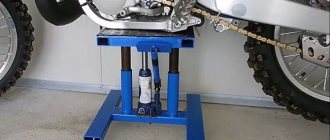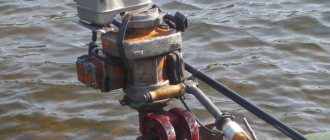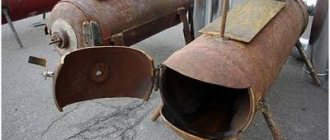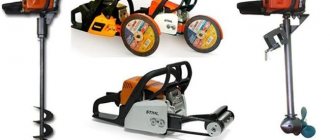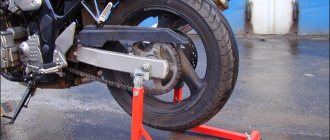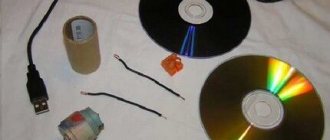The main working tool of a radio amateur or equipment installer is an electric soldering iron, which cannot be used without a stand that is suitable in size and reliable in operation.
In amateur radio practice, a homemade stand for a soldering iron is most often used, the design of which is selected depending on the specific conditions of use.
As a rule, it consists of a base and two support posts on which the tip and handle-holder of the heated soldering device are placed.
Homemade soldering iron stand with your own hands
Many offline and online stores sell good and quite convenient stands for soldering irons, and inexpensively.
But if you wish, you can make them yourself. It will be cheaper, plus you can adapt the stand to your own needs. There are a lot of ideas for making them, so we decided not to limit ourselves to just one, but to make a selection of the most interesting, in our opinion, homemade soldering iron stands, made with our own hands.
Soldering iron stand made of wire.
Let's start with the most budget-friendly, simple and common option. In it, the mount for the soldering iron is made of thick metal wire in the form of a conical spring and is attached to a wooden or other base. Instead of wire, you can use thin metal clothes hangers, which are found in almost every home.
Such a stand can be made more convenient if you install additional goodies on it, for example, a metal sponge for cleaning a soldering iron, a box for tin and rosin, or a holder for soldering.
You can make another homemade stand for a soldering iron from wire, which is a little less convenient (although this is a matter of taste) and just as easy to make.
Soldering iron stand made from fuses.
Another option is a stand that is very easy to make and does not require any money. The base is made of a wooden block or textolite; fuse jaws of the required size are attached to it on top.
Mobile stand.
A homemade mobile stand for a soldering iron, made from sheet metal obtained from a burnt computer power supply. The stand is intended primarily for people who often solder outside the home. It is quite comfortable and functional, and easily fits into a bag or even a jacket pocket.
Having such a stand, you do not have to carry tin, rosin and a clamp separately for soldering small parts. Where and what to store is clearly shown in the video, we recommend watching it.
Well, you can find the manufacturing instructions here.
DIY soldering iron stands.
Complex multifunctional stands are a matter of taste. Some people really like them, while others prefer the simple designs we showed above. In any case, the complex stands deserve attention, as they are well made. We will show only a few of them, the most interesting in our opinion.
The first stand has everything you need for comfortable work, namely a place for tin and rosin, a clamp for soldering small parts, a sponge for cleaning the tip, a built-in regulator, and the actual fasteners for quick but reliable fixation of the soldering iron.
See the manufacturing process here.
Well, and two more and no less interesting ideas in video format.
The simplest stand.
If you urgently need a stand for a soldering iron, then making something complicated is not the best idea, since haste always leads to a mess. It is better to temporarily make a simple design, and then change it to something more worthy.
The best option, which can be done in just a couple of minutes, is a wooden block with four long screws. The soldering iron fits well on it, is easy to pull out, but does not fall out on its own.
Wire soldering iron stand
Making a wire stand for a soldering iron with your own hands begins by straightening the wire itself.
To get started you need:
- Cut a piece of wire 0.3 meters long;
- Clamp one end of the wire with pliers, and then wrap the remaining length around the tool several times;
- With the other end you need to do the same procedures;
- Stretch the wire from this position in different directions with two pliers
- Next you need to start making the stand. The straight wire must be divided into several parts. It is worth making a rectangle out of it, for example, with sides of 5 and 10 cm. It is advisable to solder this structure so that it retains its shape. At the same time, you need to solder the top part. To do this you will need a few more pieces of wire. Thus, on one of the sides of the resulting rectangle there will be another “U”-shaped structure soldered to its ends. The upper part of the structure can be bent to the bottom so that the soldering iron does not roll off it.
- On the other side of the base rectangle, a similar “U”-shaped structure of the same or a different size should be made. With the same values, a homemade soldering iron stand will hold the soldering iron in a vertical position. Otherwise it will be tilted. The upper parts of the towering forms must be soldered together for stability. Then you need to check the structure for strength by installing a tool on it. If everything is fine, then the do-it-yourself soldering iron stand made of wire is ready.
How to make a soldering iron stand with your own hands?
- Tools and materials
- Manufacturing options
- PCB holder
- Recommendations
It is dangerous to use a soldering iron without a stand - if placed on any wooden surface and heated to 300 degrees or more, it will char it. The stand must contain a metal structure that removes excess heat.
Tools and materials
The following tools should be prepared in advance:
- a universal screwdriver with a set of heads or a screwdriver with bits and a wrench,
- hammer and pliers,
- a small electric drill and a set of metal drills;
- ruler, square and construction marker;
- adjustable wrench (can be used instead of a wrench).
Consumables you will need:
- a piece of natural wood board;
- self-tapping screws;
- soldering iron stand in the form of a plate or bent wire;
- a clamping element from some electronic device or household appliance;
- small container for solder and rosin;
- steel wire with a cross-sectional diameter from 2 to 3 mm.
the soldering iron itself - to check how convenient the stand you just made is for it.
Stand accessories and tools
If you have plans to make a soldering iron holder with your own hands, then you need to find the necessary tools and things that will help you realize your plans. The main items you may need for this include:
- A metal sheet;
- Wooden board;
- Screwdriver;
- Wire;
- Metal can;
- Screwdriver;
- Electric drill;
- Screws with nuts or self-tapping screws.
Depending on what kind of do-it-yourself soldering iron stand you will make, you may need a different set of tools and parts. But most people choose these options because they are the most convenient.
Manufacturing options
There are several options for stands - depending on the specific requirements for soldering functionality, choose any one.
Regular
First, prepare a wooden board - the base of the stand.
- Select a piece of board - for example, 25*12 cm.
- Mark the points on the board according to the drawing and drill holes in these places. The diameter of the holes should be slightly smaller than the cross-sectional diameter of the wire - it should fit into them with great effort.
- Cut the required piece from a coil of steel wire and mark it with a marker. Bend it along these points, as shown in the drawing. You will get an M-shaped frame - its dimensions can be, for example, as follows: two sidewalls of 5 cm each and two sides (slopes) of 3 cm each. There should be two such frames.
- Press the ends of the frames into these holes.
The simplest homemade soldering iron stand is ready. If desired, it can be modified as follows.
- If rosin and solder are sold in ready-made industrial cylindrical capsules, then drill a hole using a core drill of a slightly smaller diameter than the capsule itself. It may not be through.
- Press the capsule itself into this hole. Before inserting it, this container can be coated with glue - for example, universal “Moment-1”, then it will not fall out over time. There can be 3 of these capsules: for rosin, solder and flux. It is advisable to choose a glass container for soldering flux.
To prevent the stand, made by yourself, from scratching the varnished surface of the table, legs . Do the following.
- Cut four identical circles with a diameter of no more than 1 centimeter from a piece of thick (from 3 mm) rubber. Here, rubber from old car inner tubes can be used as a consumable material.
- Using an emery block, a sharpening stone, or a grinding machine, sand the rubber on one side and the base underneath where these circles are installed.
- Apply a layer of the same Moment-1 glue to the stand and to the circles themselves. After a few minutes, use a vice or clamp to firmly press them to the piece of wood where they are glued. Compression is also carried out by pressing with your hand on the stand installed on these mugs, and any horizontal surface that can withstand the force applied to the stand serves as a support.
After a day, the glue will completely dry and harden, and the stand can be used.
Stands of increased sizes are used for powerful soldering irons of 100 watts or more, as well as for blowtorches running on gas.
Casket
The box design is the most compact and easy to carry . It is made from any wooden or metal box shaped like a parallelepiped. The soldering folding box is a pencil case with several compartments in which capsules with flux and rosin and a roll of solder are stored.
Fixation of such a pencil case in the closed state is carried out using M-shaped wire inserts. If the pencil case is large enough in size - for example, 25 * 12 * 5 cm, then the soldering iron itself will fit into it. The volume of such a box is enough to, in addition to soldering consumables, accommodate the soldering iron itself, its power cord and plug when folded.
If you don’t find such a stand on sale, you can make it yourself from wood. Natural wood or plywood with a thickness of no more than 1 cm is suitable as a consumable material.
- Mark and cut a sheet of wood for the parts of the future soldering case.
- Connect them using furniture corner screws made from wood glue. You will get a soldering box with sections.
- Cut another piece of wood or plywood the size of the bottom wall of the pencil case. Attach it to 2 small furniture hinges. You will get a lockable box.
- At the ends of the pencil case, closer to the bottom, drill holes for wire inserts that serve as supports for the soldering iron when the pencil case is open.
- Make these inserts according to the above diagram and install them in the place intended for them.
Casket
The box design is the most compact and easy to carry. It is made from any wooden or metal box shaped like a parallelepiped. The soldering folding box is a pencil case with several compartments in which capsules with flux and rosin and a roll of solder are stored.
Fixation of such a pencil case in the closed state is carried out using M-shaped wire inserts. If the pencil case is large enough in size - for example, 25 * 12 * 5 cm, then the soldering iron itself will fit into it. The volume of such a box is enough to, in addition to soldering consumables, accommodate the soldering iron itself, its power cord and plug when folded.
- If you don’t find such a stand on sale, you can make it yourself from wood. Natural wood or plywood with a thickness of no more than 1 cm is suitable as a consumable material.
- Mark and cut a sheet of wood for the parts of the future soldering case.
- Connect them using furniture corner screws made from wood glue. You will get a soldering box with sections.
- Cut another piece of wood or plywood the size of the bottom wall of the pencil case. Attach it to 2 small furniture hinges. You will get a lockable box.
- At the ends of the pencil case, closer to the bottom, drill holes for wire inserts that serve as supports for the soldering iron when the pencil case is open.
- Make these inserts according to the above diagram and install them in the place intended for them.
- Installation of the inserts is carried out the next day - when the glue dries and hardens. The pencil stand is ready for use.
PCB holder
The simplest version of the holder is a pair of electrical installation “crocodiles”. They are positioned so that they are turned in one direction. They are installed on supports made of linear sections of the same wire from which the inserts holding the soldering iron are made. There is also a more advanced device with brackets and guides that allows you to hold printed circuit boards prepared for soldering more firmly and reliably. The PCB retainer can be installed anywhere on the stand.
Recommendations
For stands with a diode, select the diode itself in terms of power, with a margin designed for a specific soldering iron . For example, 25 W soldering irons will require a diode with a maximum operating current of 110-120 mA, and taking into account a 2-3-fold reserve to prevent overheating of the part itself, the maximum operating current will reach 0.3 amperes. The use of diodes with a reverse voltage less than 300 V is not allowed - if the voltage is at the limit or slightly beyond the limit, thermal and electrical breakdown will occur.
Do not use plastic as the main material - the heated inserts of the holders, which transfer excess heat in a matter of seconds, will quickly melt it. The holders will fall to the side, and the soldering iron will “move” off the stand onto the table.
It is recommended to use heat-resistant and non-flammable power cables. Ground the soldering iron body separately.
To learn how to make a soldering iron stand with your own hands, see the following video.
With diode
The purpose of the diode is to reduce the supply voltage by one and a half to two times. This significantly saves the life of the soldering iron.
The fact is that periodically there are significant interruptions in work when the soldering iron is not actively used. In order not to keep it constantly turned on at full power, and also to eliminate the loss of time for its complete, “from scratch”, warming up when it is needed again, a diode - or a step-down regulator - is simply necessary.
Long-term operation of the soldering iron at a temperature significantly lower than 300-odd degrees prevents the nichrome wire from which the active (heating) element is wound from burning out prematurely. Periodic overheating of the soldering iron can also cause the layer of mica to crumble, transmitting heat from the heated spiral of the steel structure to which the copper tip is rigidly connected.
To build a heat control circuit into the stand, do the following:
- Install on the stand a small-sized switch, pre-built into a small rectangular housing. In parallel, a high-voltage diode should be connected to it, designed for industrial mains voltage up to 300-400 volts. This refers to the reverse voltage that a given diode can withstand. The current strength (we are talking about direct current) must be at least 200 milliamps. All these characteristics are indicated in the description of the specific diode.
- Connect an additional power cord to the stand - it is the one that is connected to the 220 volt lighting network. Connect a switch with a diode into its gap.
- Mount a compact, small-sized socket at the output of the stand. Connect it to a switch with a diode.
Reliably insulate all live contacts. The stand with diode is ready for use.
DIY soldering iron stand
Hello, dear DIY lovers! Every soldering person new to this business has encountered a problem when there is nowhere and nothing to put the soldering iron. You have to take some objects that can withstand high temperatures (metal, for example). But the soldering iron constantly tries to roll away from them, ending up on a table or some other unwanted object (I had a case where a soldering iron heated to operating temperature fell on a laptop, the consequences were not the most pleasant). Some soldering irons come with their own standard stands, but these stands are extremely unstable and inconvenient to use. Therefore, in order to increase comfort and protect foreign objects, I decided to make a soldering iron stand and show you the process of making it.
To make this homemade product, you do not need any expensive or rare materials, everything is from what you have at hand. The manufacturing process is not the most difficult. Of course, it will take time, since homemade products cannot be done on your knees in 5 minutes.
To begin with, I used the following devices and tools:
1) Circular saw (if not, you can use a regular hand saw for wood); 2) Angle grinder (simply an angle grinder, if not available, you can use a hand saw, metal scissors and sandpaper); 3) Drill; 4) Pliers; 5) Screwdriver; 6) The soldering iron itself (to make a stand on it).
We scratch with a caliper (so that everything is parallel and “with great accuracy”) a rectangle with the dimensions we need and cut out the piece we need.
The dimensions are actually arbitrary, the main thing is to make sure that the base area does not allow the stand with the soldering iron to tip over and stands securely on the plane.
We grind (round) the edges of the workpiece using an angle grinder or a regular emery block.
The chipboard already had its own varnish coating, since this chipboard was once a cabinet door. In the future I will varnish it for a better look, but for now:
With this the foundation is ready. We begin to produce related parts. First, let’s make a “slag collector” (that’s what I called it). To do this, I took a button made of aluminum.
Instead of a button, you can take a lid from glass juice bottles or. .
In order to make it easier to remove oxides and slag from the tip of a burning soldering iron, I made the following part from a piece of galvanized steel.
Again, instead of galvanizing, you can take, for example, an aluminum sheet or an ordinary thin iron sheet. This bent plate itself is intended, I remind you, to scrape off oxides or excess solder from the soldering iron tip.
We bend it at the desired angle and cut off the excess from the plate, drill a small hole both on the plate and on the button, and secure it all to the base using a short self-tapping screw.
Let's move on to the next stage. Let's start making soldering iron holders ourselves. They will also be made from galvanized steel. To do this I did the following:
I tightened the screw too early. We unscrew it and use one screw to secure the “slag collector” (you’re probably already tired of this word) and the lower holder of the soldering iron. The large hole, as you already understood, was made to stick the nose of a soldering iron into. In this case, the soldering iron will stick its nose into its own business!
Everything had to be unscrewed again. I made some stiffening ribs on the plates, but they are of no use, since there are none at the bending points. But it will look different.
I found this aluminum plate, maybe it’s a Soviet soap dish. I will put soldering iron tips in it (as there are several types of them) and other small things intended for soldering (rosin, solder), so that everything is together.
We will also fix it on a chipboard base. But first, let's make a second holder for the soldering iron, also made of galvanized steel.
We make a groove after making a hole. The soldering iron will be inserted into this groove.
We bend it as necessary and try it on the base together with the aluminum vessel. The main thing is that the soldering iron falls into place.
Making holes for self-tapping screws
On the sides, the upper holder was also bent on the sides with pliers.
How to make a soldering iron stand with your own hands
Using a soldering iron without a stand is considered dangerous. Placing a tool heated to 300 °C on any wooden surface can cause charring. To avoid such a problem, you need to make your own stand containing a metal structure, which will remove excess heat.
The structure can be built from available materials
Soldering iron stand made from fuses
A do-it-yourself soldering iron stand using improvised materials is the simplest and cheapest way to get the desired design. To create a stand from fuses you need:
- Textolite, or as its replacement - a wooden block;
- Circuit breakers.
The block is prepared as a base, so its surface must be flat for greater stability. After preparing the base, the fuse jaws are installed on the product. The distance between them is selected individually according to the size of the soldering iron. They can be secured using self-tapping screws, since there is always a hole on the sponge where they can be located.
Tools and materials
When starting to make a stand for a soldering iron with your own hands, you should prepare the necessary materials. During the work, the master will use:
- a universal screwdriver with a set of heads or a screwdriver;
- hammer and pliers,
- an electric drill and a set of metal drills;
- ruler, square, marker;
- adjustable wrench;
- a piece of timber;
- self-tapping screws;
- a stand resembling the shape of a plate or a curved wire;
- a clamping element from an electronic tool;
- a small container for solder and rosin;
- steel wire, the diameter of which is 2-3 mm.
Having a soldering iron nearby is a must. The device will be needed to check how convenient the design is.
Manufacturing options
A do-it-yourself soldering iron stand can be made in various ways. Below are the best homemade options.
Wire stand
In order to quickly make a design that is convenient for holding a soldering iron, the home craftsman will need to prepare single-core copper wires (60 cm), a tin can, bolts, and washers. The recommended wire diameter for copper is 4 mm.
- First of all, remove the insulation from the wires.
- The wire is aligned and wound onto a pen/pencil to obtain a tight spiral.
- At the ends of the spiral, a fastening is made that resembles an eyelet in shape.
- A small hole is drilled at the bottom of the jar.
- After this, you can insert the spring into the jar. The structure is fixed using bolts and nuts. To ensure strong fastening, washers are used.
- You can place cardboard under the finished homemade structure.
Any home craftsman can make a stand from wire and a jar.
Wire stand
Multifunction device
Having spent very little time, you can make a multifunctional stand that will contain a place for solder, rosin, a soldering pad and a convenient soldering iron holder. During the work, the master will need the following materials:
- board, the width of which reaches 1 cm;
- old panel from the system unit (tin);
- a pair of glass bottle caps.
- The first step is to cut out a sketch from wood and an old panel from a system unit according to a previously prepared drawing.
- The resulting parts are cleaned with sandpaper. The edges of the blanks are bent with pliers and a pair of holes are drilled on them.
- The blanks are painted.
- Make a couple of holes in the wooden stand with a knife (for the lids) and file them down with a file.
- The wooden base is fired and covered with a layer of colorless varnish.
- The covers will need to be glued with epoxy resin, and the tin parts will need to be screwed using self-tapping screws.
The multifunctional design allows you to conveniently solder tin, brass, copper products, polypropylene pipes, etc.
In the free part of the base you can fix a jar of rosin
From scrap material
By using materials that are available in the house, you can save the costs required to make the stand. To build a convenient structure you will need to prepare:
- coarse sandpaper;
- hacksaw for metal;
- Phillips screwdriver (you can use a screwdriver);
- thin screwdriver;
- iron plate;
- a spring that can be removed from the pen;
- a tin covering the board (can be removed from a broken receiver);
- metal retainer from the antenna;
- self-tapping screws 20 mm - 4 pcs.;
- bolts - 4 pcs.;
- Thin-sheet chipboard (up to 18 mm).
Also during the work, in addition to improvised means, you will need pliers and 2 rubber stoppers from chemical test tubes.
For reference! On Avito or Yula you can find craftsmen who make interesting and unusual stands for soldering irons. Such products look almost like works of art.
- The cut chipboard sheet is sanded, giving it a rounded shape.
- Rubber plugs are sawn straight. To achieve uniform thickness, you should use sandpaper.
- 1 self-tapping screw is screwed into each rubber leg.
- Holes are made in the structure and legs with screws are screwed in.
- The iron plate is bent, giving the outline of a hook.
- Using a screwdriver, holes are made for a pair of bolts intended to secure the hook.
The final stage of making a stand from scrap material will be tightening the bolts and checking how well the hook holds.
Plastic cannot be used as the basis for homemade products.
Fuse stand
To make a fuse holder at home, the craftsman will need to purchase fuses and a wooden block. The latter will serve as the base.
It is very important that the surface of the bar is smooth. The fuse jaws are installed on the base at a distance that will be identical to the dimensions of the soldering iron. The jaws of each fuse are fixed with self-tapping screws. Convenient design is ready for use.
From scrap material
By using materials that are available in the house, you can save the costs required to make the stand.
To build a convenient structure you will need to prepare:
- coarse sandpaper;
- hacksaw for metal;
- Phillips screwdriver (you can use a screwdriver);
- thin screwdriver;
- iron plate;
- a spring that can be removed from the pen;
- a tin covering the board (can be removed from a broken receiver);
- metal retainer from the antenna;
- self-tapping screws 20 mm - 4 pcs.;
- bolts - 4 pcs.;
- Thin-sheet chipboard (up to 18 mm).
Also during the work, in addition to improvised means, you will need pliers and 2 rubber stoppers from chemical test tubes.
For reference! On Avito or Yula you can find craftsmen who make interesting and unusual stands for soldering irons. Such products look almost like works of art.
Step by step guide:
- The cut chipboard sheet is sanded, giving it a rounded shape.
- Rubber plugs are sawn straight. To achieve uniform thickness, you should use sandpaper.
- 1 self-tapping screw is screwed into each rubber leg.
- Holes are made in the structure and legs with screws are screwed in.
- The iron plate is bent, giving the outline of a hook.
- Using a screwdriver, holes are made for a pair of bolts intended to secure the hook.
- The final stage of making a stand from scrap material will be tightening the bolts and checking how well the hook holds.
PCB holder
In order to make the structure, you will need to stock up on wooden blocks and corners. The dimensions of the product are selected individually depending on the dimensions of the soldering iron.
For example, the length of the first three bars can reach 40 cm, the fourth and fifth should not exceed 30 cm. The length of the remaining four should be 18 cm. It is best to use powerful corners. You need to drill 8 holes on each of them.
It is also worth purchasing bolts for M8 and for them in advance:
- washers;
- nuts;
- wing nuts;
- spring.
- From a sheet of fiberboard you need to make 4 blanks, the size of which will be 70x20 mm.
- In 2 blanks, using a stationery knife, cut out recesses for wing nuts (2 recesses on each).
- A piece of chipboard with a wing nut is glued to another piece in which no holes were drilled. Glue the remaining 2 parts in the same way. As a result, we manage to get a couple of blanks.
- After this, you will need to make notches and triangular recesses for gripping the board with a stationery knife. The notches are processed with a metal file and smoothed with a file.
- At the next stage, the racks are prepared. It is necessary to make a couple of through holes in the upper part and across. Each half is cut halfway through in order to reduce the resistance of the wood at the moment of fixing the holders.
- Having made oblique cuts, you need to drill holes for fasteners and make a countersunk hole for the caps.
- 2 long bars for the base are laid parallel to each other. The distance between them depends on the length of the soldering iron. The third bar is placed parallel to them and securely fixed.
- The finished racks are attached to the corners.
Soldering iron stand with power regulator
This type of design is equipped with a device that independently adjusts the heating level of the hand tool. This prevents overheating of the device and extends its service life. In the process of making the stand, the home craftsman will use:
- copper wires;
- a piece of plywood;
- elements for fixation;
- tin boxes;
- rubber feet;
- socket.
You will also need a transformer, diodes and a resistor.
- During the assembly work, the master assembles a power level control board according to the diagram.
- Using a heat gun, you need to make a plastic blank for the board body and solder the corners of the tin box.
- At the next stage, a tin box is made for the brush, with the help of which the tip is cleaned and the stop for the device is assembled.
- Next, the bolts on the clamp are soldered (like a third hand) and the base of the structure is made of plywood, on which a recess is cut for further placement of rosin melted with a hairdryer.
- Metal boxes, clamps and stands are fixed, after which the board is screwed in and the housing part is secured.
The final stage of making the stand is to screw the brush box and fix the anti-slip rubber feet on the back side.
The foundation for the structure must be stable
The abundance of options for making stands at home allows each craftsman to choose the most suitable method for himself. By strictly following the step-by-step guide, you can quickly build a convenient design that will prevent damage to surfaces when using a soldering iron.
How to make a soldering iron stand
The main working tool of a radio amateur or equipment installer is an electric soldering iron, which cannot be used without a stand that is suitable in size and reliable in operation.
In amateur radio practice, a homemade stand for a soldering iron is most often used, the design of which is selected depending on the specific conditions of use.
As a rule, it consists of a base and two support posts on which the tip and handle-holder of the heated soldering device are placed.
General requirements for materials and design
You can make a high-quality stand with your own hands, used for soldering various products and metal parts, from any available means that meet the following requirements:
- reliability and stability of the foundation;
- fire resistance of the material of the support posts;
- availability of space for containers with rosin and solder.
The simplicity of the device in question does not mean at all that you can use low-quality parts to assemble it and treat it as something not particularly important.
On the contrary, to make a stand for a soldering iron you will need durable and reliable materials suitable for working at high temperatures, as well as accurate calculation of the dimensions of the base with holders and containers placed on it.
Jars of rosin and solder attached to the base must be placed in an order corresponding to the sequence of operations performed during soldering and not interfere with the work with the soldering iron.
Some craftsmen place soldering irons along with a power regulator on such stands, which significantly complicates the design of the entire device as a whole.
Unlike small-sized factory samples, self-made stands must have dimensions sufficient to accommodate all the elements listed above.
Sometimes such devices are equipped with a special holder for a soldering iron (the so-called “third” hand), which allows you to fix the workpieces or parts being processed. One of the simplest product options is a crocodile-type holder.
Drawings and models
I haven’t sat down to draw for fifteen years, so if something is not clear in the drawings, please let me know in the comments.
Base (foil plate 12 mm):
Plate for the soldering iron handle (12 mm plate):
Soldering iron plate fastening plates (2 mm sheet), two identical pieces:
Blade holders (square rod 10x10 mm), three identical pieces:
Sources of all drawings and 3D models of printed parts are available in this project.
Simple version
To assemble a simple, convenient stand with a minimum of parts yourself, you may need the following consumables:
- a wooden flat piece made of beech or oak measuring approximately 25 by 12 cm, necessary for making the base of the soldering iron stand;
- duralumin plates no more than 1.5 mm thick;
- miniature metal containers (brass cups from an old-style telephone call can be used to make them).
After all this material has been prepared, you can proceed to assembling the stand for the soldering iron itself, starting with preparing the seats for containers with rosin and solder.
In the case of using brass cups from a ringing device (bell), they are simply screwed to a wooden platform in a pre-designated location.
After this, triangular or oval shaped supporting elements are made from a duralumin plate (the distance between them is selected according to the length of the soldering iron).
The supports formed in this way are attached to the base of the stand using self-tapping screws or large screws.
If necessary, the height of the supports for placing a soldering iron can be increased by lengthening them using short metal stands with threads at the ends.
All prepared parts should be carefully processed with a file, and then their surfaces should be cleaned with sandpaper, which will smooth out sharp edges and remove dangerous burrs.
Third hand holder
To solder individual parts or products, it is very convenient to fix them in a certain position, freeing up the hand in which the soldering iron should be located. For these purposes, a special device is used, which is sometimes called a “third” hand soldering iron stand.
To assemble it you will need the materials and tools shown in the photo above. The list of required parts includes alligator clips, holders for decorative candles and any spring of suitable size.
The basis for such a design can be a Chinese-made product, equipped with a magnifying glass and containing all the necessary elements.
When assembling such a stand, first, at some distance from the center of the base, a spiral holder for a soldering iron is attached, after which candle holders are inserted into pre-drilled niches.
Before installing them, you need to pay attention to the thickness of the walls of the cups, selected for reasons of optimal thermal conductivity. And only after this will it be possible to insert them into already prepared niches, having first coated the bottoms with glue, and then align the edges flush with the plane of the wooden base.
After installing the containers for rosin and solder, it will be possible to fix the “crocodiles” by crimping them around the spiral. The height of their location is chosen in such a way that working with the soldering iron and the part does not cause any difficulties.
For ease of soldering, the spiral design may provide for vertical adjustment of the clamps.
If necessary, a magnifying glass (magnifying glass) can be additionally included in the assembled soldering iron stand. However, experimental operation of such devices has shown that the simultaneous installation of auxiliary clamps and a magnifying glass on the stand creates certain inconveniences in working with them.
The choice of options for making a stand with your own hands is quite varied, and depends on the materials that the master has at his disposal.
If you don’t want to do it yourself, you can always buy a ready-made stand at a soldering accessories store.
Stand with “third hand” device
This design allows you to work with the soldering iron as comfortably as possible, without wasting effort on holding the soldering iron and the two parts being connected at the same time. It is quite deservedly called the “third hand”.
To make it you will need the following available materials and accessories:
- two glasses from decorative candles;
- a leg from an old table lamp or small lamp;
- two alligator clips;
- a magnifying glass that will make it much more convenient to work with small details;
- a spring retainer, which you can make yourself from ordinary steel wire;
- wooden base.
The first step is to prepare the basis for the future stand. To do this, we mill three niches in it. The first two will be used to install candle cups, and the third will be used for a cleaning cloth that removes solder from the soldering iron.
After this, all work is performed in the following sequence:
- We mount the cups in the prepared niches.
- We mount alligator clips onto the flexible lamp rod. It is better to make the distance between them adjustable.
- We install the spiral soldering iron holder in one of the corners of the base.
- We drill holes and screw the rod with clamps to the wooden stand.
- If desired, you can attach a magnifying glass to the top of the “third hand”. Also very often it is made removable or installed on a separate rod.
- This stand does not require significant financial investments, but makes working with a soldering iron easier.
